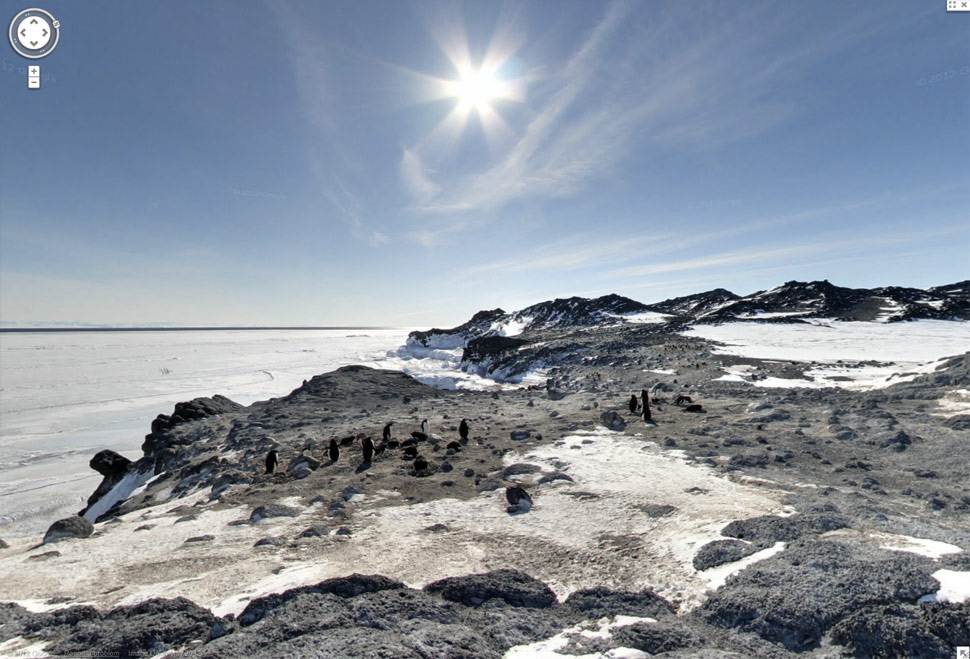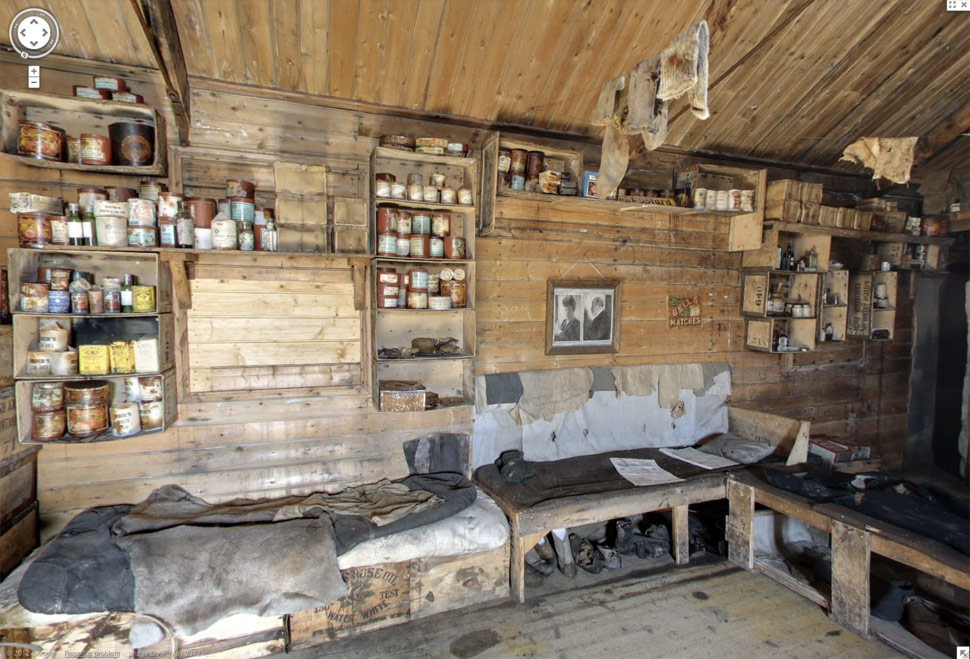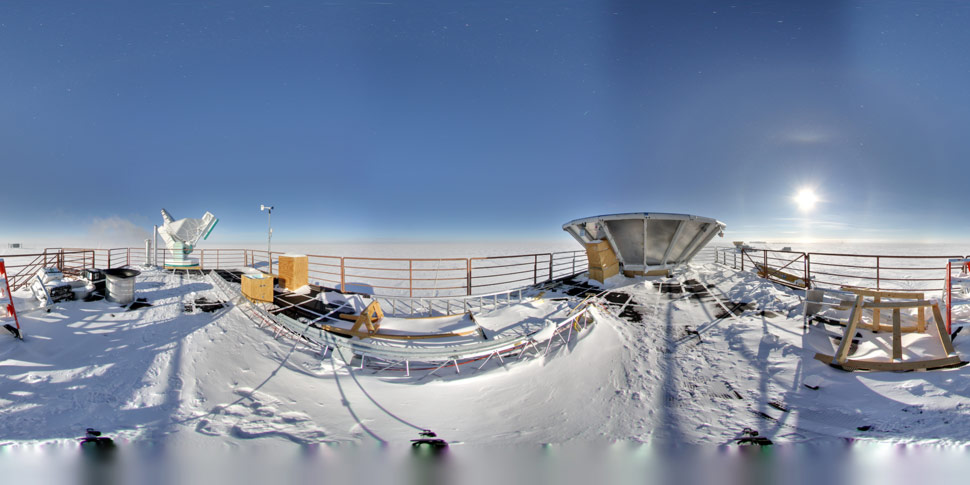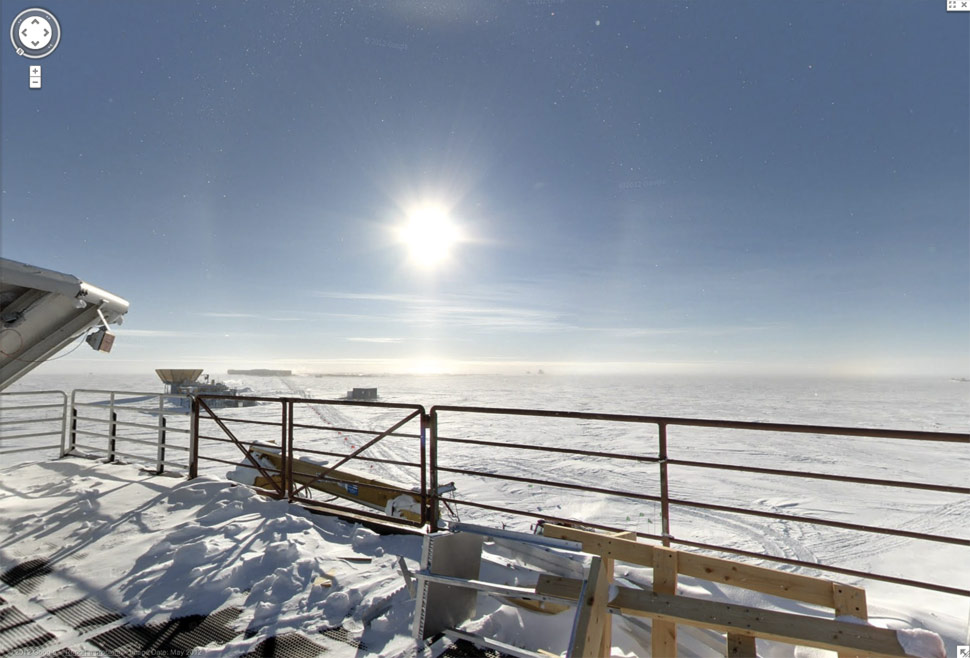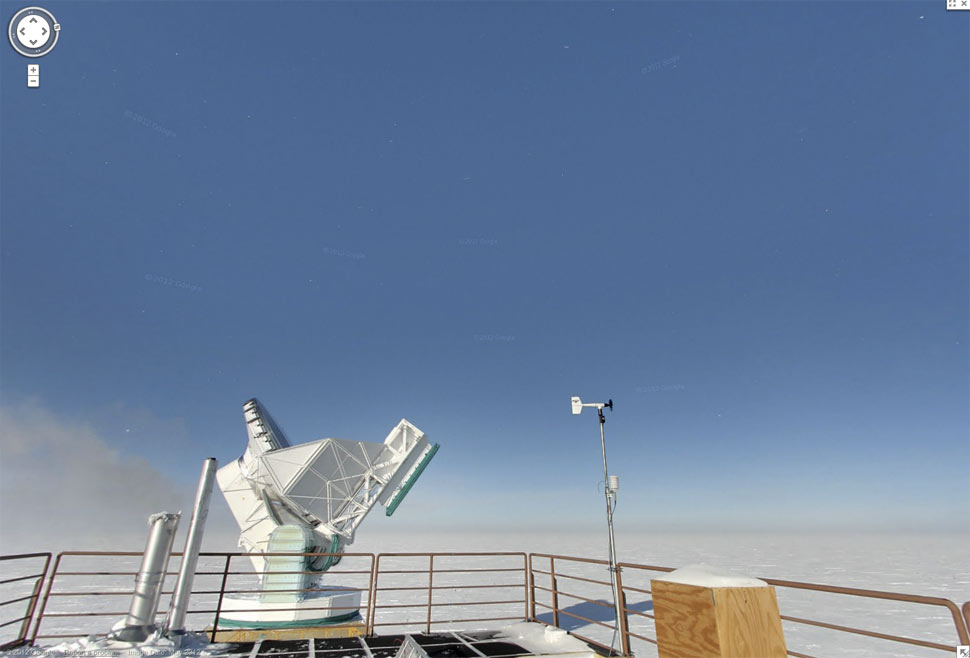Interview - by Big Dead Place
HERE
Interview with The Shadow
The Shadow was an underground paper published in McMurdo in the early
'90s. Big Dead Place conducted this interview with the anonymous editor
via email.
How did The Shadow begin? 
It was winter of 1990 and the Navy was putting out this dry, no fun,
Navy-type paper and we actually just wanted to poke fun at it. Well, as
you
know, there are many things to poke fun at down here, so it just took
off.
How many people were involved?
Twelve core people (American and Kiwi), and about 100 anonymous contributors.
What were some of the reactions when The Shadow was first published?
The Navy went ballistic and the community was belly laughing at
brunch. The Navy hated it or, I should say, the Navy Paper Staff hated
it, and the rest of the community loved it. We would sneak in just after
the Navy Sunday paper was put out in the galley and place ours right
next to it. This really pissed off the Navy and added fuel to the paper
wars.
(Please understand that when I say 'Navy' I am only referring to maybe
six
people. The rest of the Navy personnel loved it and contributed to
it.)
How did the Navy try to stop you? Did they say that The Shadow could not be produced with government paper on government machines?
That is exactly how they tried to stop us. So we told them that we had
all of the paper airdropped to us that year. They could not prove that
we didn’t. When they told us to stop using government copy machines,
Scott Base spoke up and said that we were using theirs.
When we placed our
Shadow sign on the metaphysical pole at
Derelict Junction, the Navy had
it taken down, but failed to properly dispose of it, and so it was
returned to us by a good Navy SeaBee and then we were able to get the
Linemen to place it at the top of the pole where it remained until
around 1999/2000.
What's the "metaphysical pole"?
It is the utility pole at Derelict Junction next to the bus stop. The
pole was never supposed to be put there, so it wasn’t there, so to
speak. (Sort of like when the big guys correct you on "the galley"
saying it is "the dining facility." Two syllables versus six. If it
were an acronym, like DINFAC, that would be different.)
Did the Navy Brass approach you personally?
Yes.
Tell me that story. What kind of questions did he ask you?
I was approached because I was the most outstanding point of contact for
people to contribute their writing to. Everybody knew that I was
involved. I was stopped in 155 and asked questions: about who was
involved, were they military, and was I aware that some people were hurt
by what we wrote. I had to laugh because we did not write about any
individuals; we would make jokes of entire departments such as our "make
extra money by selling brains to the Navy" ad. It was no big deal. The
Navy could not stop us and they knew it.
Once we found out that
The Shadow was being faxed to the Navy Brass in the States, we came out with the
'international issue' and explained that now we would have to raise subscription rates due the added cost of sending
The Shadow overseas. We did not wish to burden the U.S. Taxpayers
with a
ten-dollar-a-minute INMARSAT phone line transmission so we asked the
community to kick in what they could to help offset waste, fraud, and
abuse by the
Navy.
Did the reception to it change over time?
It grew into a cult following. It just got bigger and funnier. We got so many
submissions that we just could not print them all. What got printed was what made us laugh.
Were there any other papers in McMurdo that you knew of before you did The Shadow?
Just the Navy paper,
The Antarctic Night Times.
Did The Shadow spark any other people to put out papers afterwards?
Not while I was involved with
The Shadow. The original
Shadow
was in '90. In '91 it was there but I was not. In '92 it came out but
that was the year that it used to slam and be a bit on the mean side so I
opted out and hooked up with Bob [S.] and put out
The Quick Brown. We had no problems with
The Shadow staff and they had no problems with us. Actually
The Shadow sort of went away that season.
What other papers have you seen over the years, if any?
I am not sure. I have only wintered six times over the last fifteen years so I bet there were some.
 Will you explain Marsgrams?
Will you explain Marsgrams?
Before telephones we could only contact home by shortwave radio, so we
were allowed 50 words in the summer and 100 in the winter. You would
write a message and a volunteer would send it via shortwave to the
States where it would be printed out and mailed to whomever you were
sending it to. The people on the other end that printed and mailed got
money from the government to do this for the military. We were all
working under Navy orders back then, which was cool because here were
all these hippies with earrings and hair to the middle of their backs
traveling with Navy order documents.
What was your distribution process?
Getting drunk on Saturday night during the printing, and sleeping in on
Sunday. Remember, this was before computers. We asked that everything
be typed out before they slipped it under our door, so all we had to do
was cut-and-paste it to a piece of paper then run it through a copy
machine.
What department's photocopier did you use?
Mostly Power and Water, seeing how most of us worked there. Even the supervisor was involved.
When you distributed the papers did you do it a certain way so as not to get caught?
We did try to sneak them [into the galley], but the times we were seen nobody said a thing.
What were some of your editorial policies?
No slamming individuals. You could crack jokes all you wanted about any organization, and slam us, but no one by name.
Did some people submit things attacking individuals?
Yes. But that was toward the end of July, when most people get "8 up" or
their ice wife leaves them for someone else. It was how we read it.
If we thought it was a slam we didn’t go there or we would change it so
as not to hurt anyone. Although we did push the envelope at times when
it came to supervisors. Like when we cracked jokes about the FEMC
supervisor's hemorrhoid problem. He laughed at it.
There was a cartoon in one issue depicting a plumber's brain. It showed a neocortex that handled watching
TV and drinking (or something like that) with a cigarette poking from the frontal lobe.
Did The Shadow ever receive any aggressive response from those it made fun of, like plumbers?
No, but the rebuttals we would get from, say, the plumber shop to the
fitters'
shop were great. I really do not remember that one, I'll have to comb
through my collection.
I would like to add that my favorite issues were the mini-issue where we
shrunk everything down so that it would fit in your pocket, and the
sticker issue. That was the most fun issue I think we ever did.

ORIGINAL CONTENT HERE
The Symmes Antarctic Intelligencer
The Symmes Antarctic Intelligencer is a satirical
newsletter based in McMurdo and first distributed during the summer of 1999-00 at McMurdo, Pole, and various
field camps.
Though indigenous Antarctic media is rare and fleeting,
small press has been a fixture in Antarctica since at least the early 1900s when
Shackleton edited The South Polar Times. Later, during IGY in 1957-58 at
Ellsworth Station, seismologist John Behrendt recorded the controversy
surrounding the publication of a newsletter called The Daily Sandcrab.
A scathing paper called The Shadow emerged in McMurdo in the early '90s
and irked Naval officers all the way up to Washington D.C. In short,
though it can be difficult to find, Antarctic small press has a long
history.
Though relatively new, The Symmes Antarctic Intelligencer is probably the first paper to be outright seized by managers
at South Pole Station. Following a wave of scuttlebutt caused by the
paper's distribution in McMurdo a few days previous, a package of the newsletters was intercepted in the mailroom
at Pole and then confiscated, while the intended recipient
was taken to Human Resources for questioning. (It is unclear why a goofy newsletter
of any stripe represents a Constitutional Emergency that demands
the theft of mail, but for more information on National Science Foundation
policies regarding the dreary upkeep of American freedoms in Antarctica, contact the NSF
Media Representative at pwest@nsf.gov. If you love to contact Media
Representatives, but you need a conversation-starter, try these
uncomfortable topics.)
The Symmes Antarctic Intelligencer is published only very infrequently.
Past issues are available here in PDF format for ease of reprinting. Each
file is available in Kiosk-size (smaller files for kiosk connections) and Crary-size
(higher resolution files for lab connections).
"We are pleased to send greetings for Midwinter's Day 2002 to
managers and others who are stationed in Antarctica. This special
holiday is a powerful time to recognize your contributions to learning,
knowledge, discovery, wisdom, intuition, and bold championship on the
wings of golden destiny. The managers of New Denver would like to
extend a professional but slightly positive message that is also
self-promoting."
"Denver Celebrates Denver Appreciation Day"
"Raytheon Introduces Safety Assault System"
"Rescue Flight Scheduled for October 2nd"
"Fact-Finding Investigation Finds Fault"
"Support Group Attempts Unsupported Antarctic Crossing"
"NSF Seizes Unauthorized Shower Curtain"
"ANG OAE Stays Three Weeks"
"Galley Sneezeguard Breaks Off, Blocks Shipping Channel"
"Magic Elf Appears at Pole; NSF Refuses Shelter"
"DV Demands Harem, Precious Jewels"
"South Pole Feudal Lord Loves Raytheon, Hates Free Speech"
"U.S. Begins Construction on Top of Scott Base"
"HR Helps Employee"
"NSF Declares Outdoors Off-Limits"
"Defense Contractor, Nazi Party Vie for NSF Support Contract"
"Crary Road Closed, Grantees Lock Selves in with Guns"
MORE HERE






















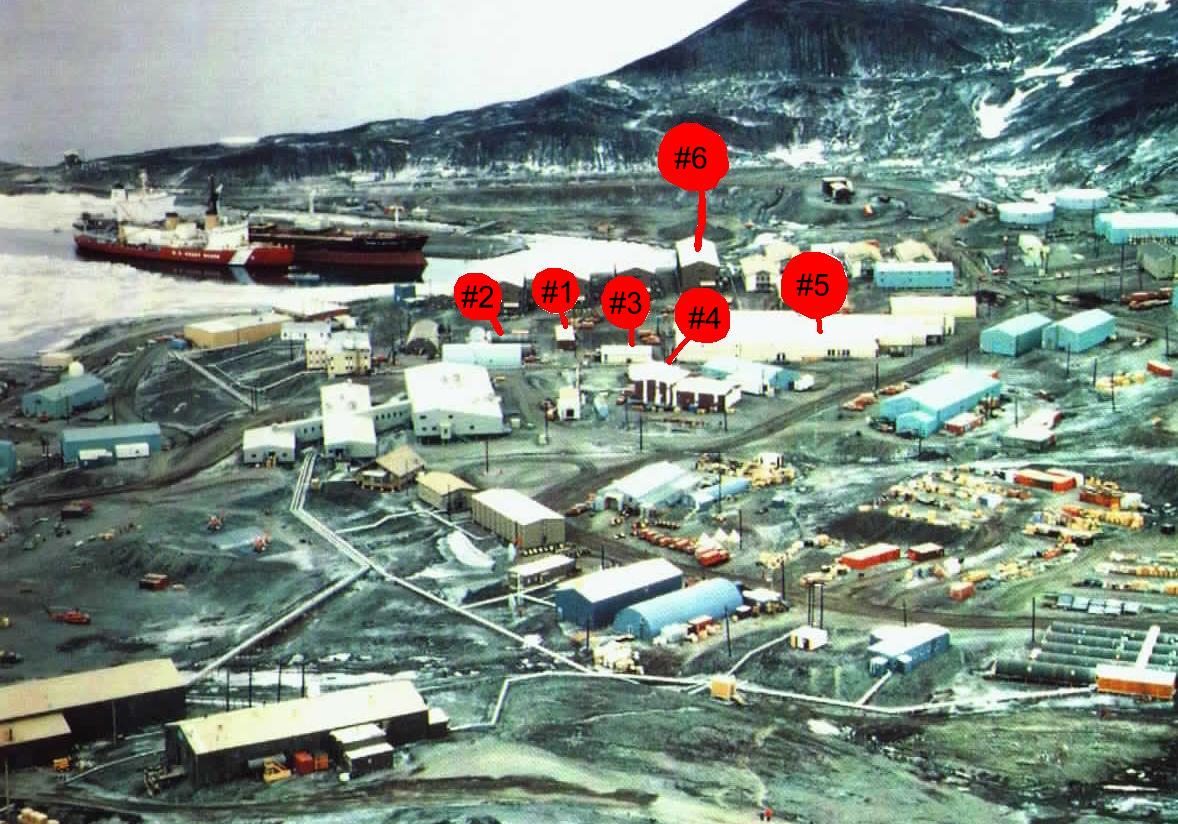
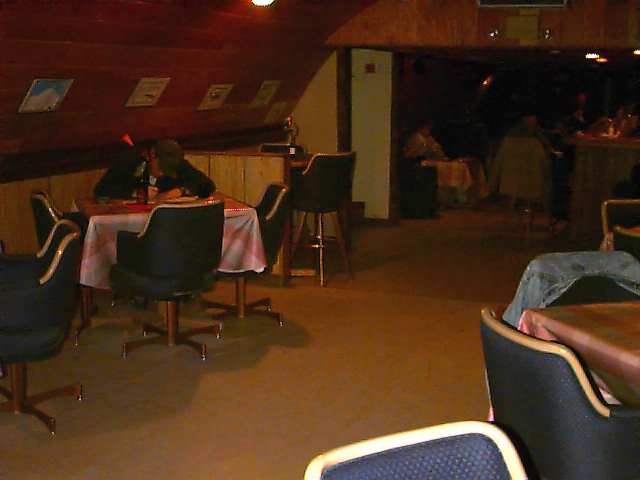
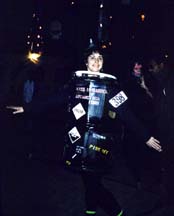 Halloween Party:
Halloween Party: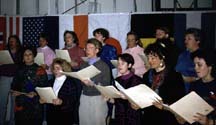 After
the party, there's a choir recital and carol sing-along in the dining
hall. Despite the absence of family, there's something quite peaceful
about celebrating Christmas in Antarctica. Perhaps it is the complete
absence of commercials. (No one's trying to sell you anything, so the
Christmas Spirit arrives unsullied by advertisements and commercialism.
It's very liberating.) Perhaps it is because you are a million miles
away from everything else, away from the war, crime, and other problems
of the world. Or perhaps it is because you are in one of the most
beautiful places on Earth, just a few hundred of you in a frozen corner
of the world, surrounded by as much white as any Christmas could ever
want. Whatever the reasons, Christmas in McMurdo always seemed to me to
be more peaceful than anywhere else I'd been.
After
the party, there's a choir recital and carol sing-along in the dining
hall. Despite the absence of family, there's something quite peaceful
about celebrating Christmas in Antarctica. Perhaps it is the complete
absence of commercials. (No one's trying to sell you anything, so the
Christmas Spirit arrives unsullied by advertisements and commercialism.
It's very liberating.) Perhaps it is because you are a million miles
away from everything else, away from the war, crime, and other problems
of the world. Or perhaps it is because you are in one of the most
beautiful places on Earth, just a few hundred of you in a frozen corner
of the world, surrounded by as much white as any Christmas could ever
want. Whatever the reasons, Christmas in McMurdo always seemed to me to
be more peaceful than anywhere else I'd been.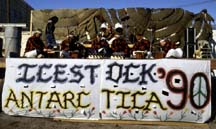 Icestock:
Icestock: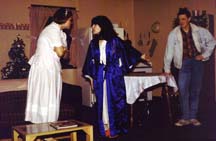 Theatrical Play:
Theatrical Play: